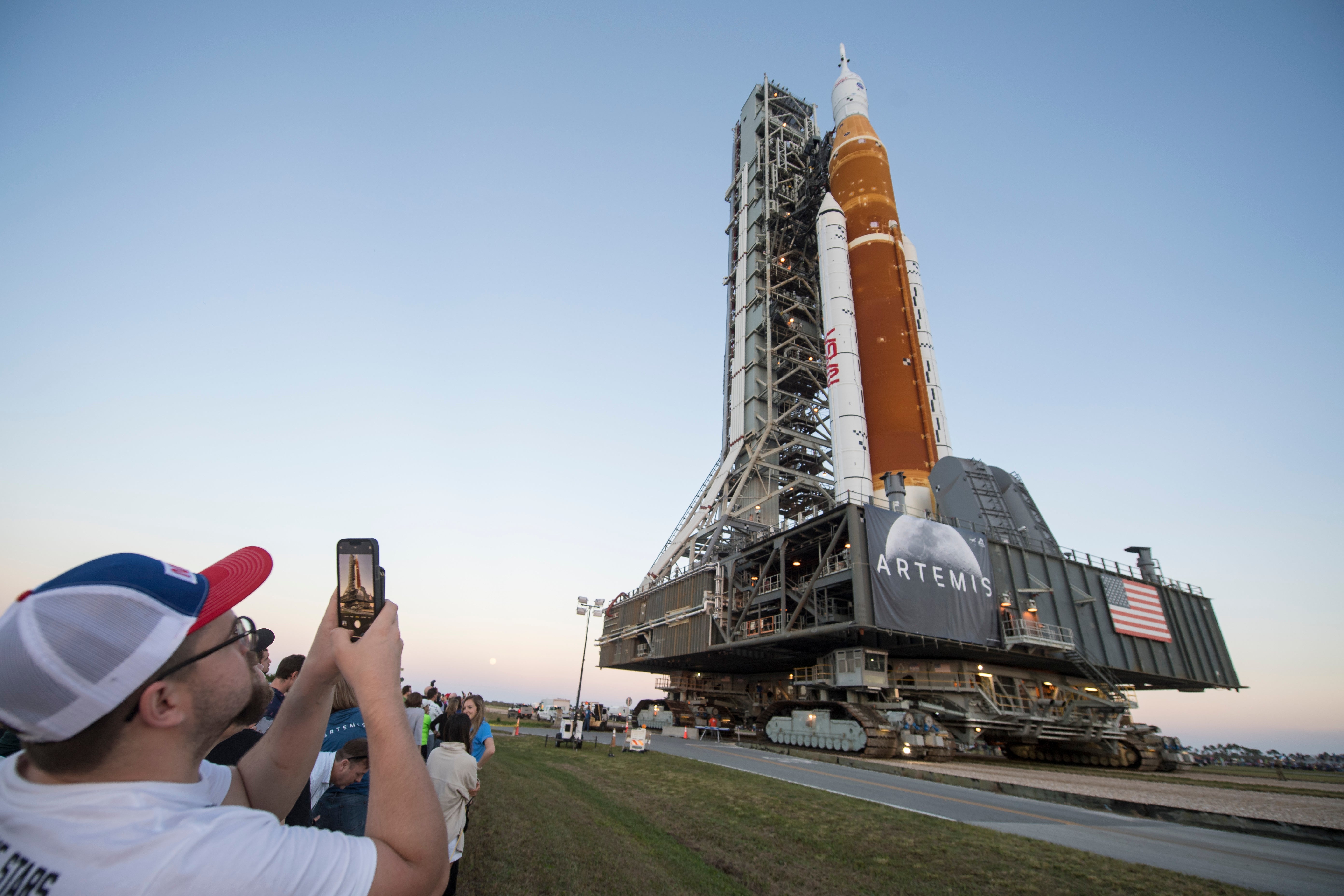Nasa officials outline 29 August Artemis I Moon mission
The long-awaited first test flight of Nasa’s new Artemis Moon program could take to the skies by the end of August

Nasa’s long-awaited return to the Moon could begin as soon as 29 August, and the excitement was hard to miss even in the sober voices of Nasa officials and engineers during a press conference Wednesday.
“The Saturn five took us to the moon, half a century ago,” Nasa Administrator Bill Nelson said. “Now, as we embark on the first Artemis test flight, we recall this agency’s storied past, but our eyes are focused not on the immediate future, but out there.”
Artemis is Nasa’s new Moon program, and the upcoming flight on 29 August is dubbed Artemis I. It will be an uncrewed test flight to test Nasa’s huge Moon rocket, the Space Launch System, or SLS, and the Orion spacecraft, which will fly to, around, and beyond the Moon before returning to Earth 42 days later.
It’s a mission that will pave the way for Artemis II in the spring of 2023, a crewed lunar flyby, and Artemis III in 2025, which will fairly land humans on the lunar surface for the first time since 1972.
“NASA will land the first woman and the first person of color on the moon,” Nelson said in his remarks on Wednesday. “On these increasingly complex missions, astronauts will live and work in deep space. And we’ll develop the science and technology to send the first humans to Mars.”
Nelson and other Nasa officials provided an overview of the Artemis I mission and answered questions from the media about the upcoming test flight.
The SLS rocket and Orion are currently housed in the Vehicle Assembly Building at Kennedy Space Center, but will “roll out” to launch complex 39B around 18 August, according to Nasa Artemis Mission Manager Michael Sarafin.
“That will signal that launch is near,” he said.
The entire 32-story rocket and launch platform will be positioned over the flame trench at the launch complex by 27 August, and tanking operations, loading the rocket with liquid hydrogen fuel and liquid oxygen propellant, will begin the morning of 29 August. If they launch is scrubbed, Nasa has follow up launch windows on 5 and 6 September.
If all goes for launch, SLS will list off on a plume fire generating 8.8 million pounds of thrust, 15% more powerful than the Saturn V rocket of the 1960s and 70s, Mr Nelson pointed out.
“The 32-story tall rocket will climb its way up through the atmosphere and in two minutes all the solid propellant the boosters will be consumed and will be jettisoned, as well as all the liquid fuel in eight minutes, and the core stage will be jettisoned,” Mr Sarafin said. The rocket’s upper stage and Orion will make a lap around the Earth as Orion extends its solar arrays to get off battery power, and if all looks good, “At that point the rocket has done its job and now Orion is on its way to the moon.”
Unlike the Apollo missions, which entered an equatorial orbit around the middle of the Moon, Artemis 1 will enter a polar orbit, “an elliptical orbit around the moon that is as if it is the face of a clock facing us,” Mr Nelson said. But it won’t stay there, and will continue out another 38,000 miles from the Moon.
“Orion will be some 270, 275,000 miles from Earth at that point at its farthest point,” Mr Sarafin said. “It’ll be farther than any human capable spacecraft has ever gone.”
All of which will be in service to the four main objectives for the Artemis I mission, according to Sarafin.
One objective is to demonstrate the SLS rocket and Orion can safely fly as intended, another is to collect as much data on the flight as possible. The third is to deploy small satellites to conduct science and take images of the mission to share with the public.
The final, and most important object is to test the Orion Spacecraft’s heat shield.
“After its long flight test, Orion will come home faster and hotter than any spacecraft has before, ‘’ Mr Nelson said. “It’s going to hit the Earth’s atmosphere at 32 times the speed of sound,” using friction to bleed off all the energy imparted to it by the massive SLS rocket at the time of launch.
It will take about 20 minutes from the point of peak heating until Orion slows enough for its parachutes to open, according to Mr Sarafin. “Then it will splash down at about 20 miles an hour in the Pacific,” he said. “A US Navy-NASA team will receive the awaiting spacecraft and will retrieve all the data off of it.”
Nasa will push Artemis I faster and harder than it would a flight with humans aboard, according to Mr Nelson, all in service of learning as much as possible ahead of the first human missions back to the Moon.
The Artemis program itself is designed as an experimental training ground where Nasa can learn all it can about the technologies and human operations necessary to go far beyond the Moon in an eventual crewed mission to the Red Planet.
“We’re going back to the moon in order to learn to live and work to survive,” Mr Nelson said. “We’re going to learn how to use the resources on the moon in order to be able to build things in the future as we go not a quarter of a million miles away, not a three day journey. But millions and millions of miles away, on a months and months, if not years journey.”
Join our commenting forum
Join thought-provoking conversations, follow other Independent readers and see their replies
0Comments